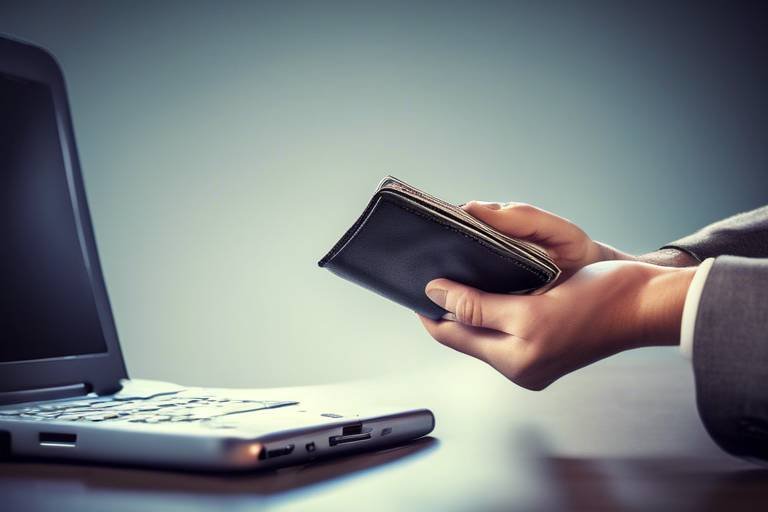Banking Safety - Wallets Vs. Online Banking
In today's fast-paced world, the way we manage our finances has evolved dramatically. With the rise of technology, banking safety has become a crucial topic of discussion. Many people find themselves torn between traditional wallets and the convenience of online banking. Which method is safer? This article dives deep into the security aspects of both options, exploring their vulnerabilities, security measures, and best practices for safeguarding your personal finances in this digital age.
Let’s start with the basics: traditional wallets. These handy little companions are designed to carry cash, cards, and other personal items. But how secure are they? One of the primary security features of a wallet is its physical protection. A sturdy wallet can prevent unauthorized access to your cash and cards, but it’s not foolproof. The risk of theft is ever-present, especially in crowded places. Imagine walking through a busy market and someone deftly slipping your wallet from your pocket. It’s a nightmare scenario that could lead to financial chaos.
To combat this, many people opt for wallets with built-in security features such as RFID blocking technology, which protects against electronic pickpocketing. Additionally, being mindful of your surroundings and choosing discreet storage options can significantly enhance your wallet's security. Always remember, it’s not just about having a wallet; it’s about how you use it.
Now, let’s shift gears and talk about online banking. It’s convenient, fast, and allows you to manage your finances from anywhere. But what about safety? Online banking platforms employ a variety of security protocols to protect users’ financial information. One of the most significant measures is encryption, which ensures that your sensitive data remains private during transactions and storage.
So, how does encryption work? When you conduct a transaction online, your data is converted into a coded format that can only be deciphered by authorized parties. This means that even if a hacker intercepts your data, they won’t be able to read it. It’s like sending a secret message that only your bank can understand!
There are two main types of encryption used in online banking: symmetric and asymmetric. Symmetric encryption uses the same key for both encryption and decryption, while asymmetric encryption employs a pair of keys – a public key and a private key. Each type has its strengths, contributing to the overall security of online transactions.
The effectiveness of encryption directly influences user safety. Robust encryption measures can significantly mitigate risks associated with online banking. Think of it as a high-tech lock on your digital door; the stronger the lock, the safer your belongings are from intruders.
Another layer of security that online banking offers is two-factor authentication (2FA). This process requires you to provide two forms of identification before accessing your account. For instance, after entering your password, you might receive a text message with a verification code. This extra step helps prevent unauthorized access, making it much harder for cybercriminals to break into your accounts.
Now that we’ve explored both sides, let’s compare their vulnerabilities. Both wallets and online banking have their own sets of risks. Traditional wallets are susceptible to physical theft, while online banking faces threats like cyber theft and data breaches. Understanding these vulnerabilities is essential for making informed decisions about your personal finances.
Physical theft involves someone stealing your wallet, which can happen in various ways, such as pickpocketing or snatching. On the other hand, cyber theft can occur through phishing scams, malware, or hacking attempts. Each scenario requires different precautions, but both can have devastating consequences for your financial health.
Fraudulent transactions can happen in both wallets and online banking. For wallets, losing your cards can lead to unauthorized charges. In the online realm, hackers can exploit weak passwords or phishing attempts to make fraudulent transactions. Being proactive and vigilant is key to protecting your finances in both cases.
Whether you prefer the traditional route or the digital path, there are best practices you can follow to enhance your banking safety. For wallets, consider choosing one with RFID blocking technology and always be aware of your surroundings. When it comes to online banking, regularly update your passwords, recognize phishing attempts, and monitor your account statements for any unusual activity.
Practical advice for securing your wallet includes selecting the right storage options, such as keeping it in a front pocket rather than a back pocket, and being mindful of crowded places. Simple habits can go a long way in preventing theft.
For online banking, here are some essential tips:
- Use strong, unique passwords for your accounts.
- Enable two-factor authentication whenever possible.
- Be cautious of unsolicited emails or messages asking for personal information.
- Regularly check your account for unauthorized transactions.
1. Is online banking safer than using a traditional wallet?
While both have their risks, online banking employs advanced security measures like encryption and two-factor authentication, making it generally safer if proper precautions are taken.
2. How can I protect my wallet from theft?
Choose a wallet with RFID blocking, keep it in a secure location, and stay alert in crowded areas to minimize the risk of theft.
3. What should I do if I suspect fraudulent activity on my account?
Immediately contact your bank or financial institution to report the suspicious activity and take steps to secure your account.

Understanding Wallet Security
When it comes to safeguarding our finances, the first line of defense is often our traditional wallet. But what exactly makes a wallet secure? It's not just about the material it's made from; it's about the various security features that come into play to protect our cash and cards from unauthorized access. Think of your wallet as a treasure chest; if it’s not locked up tight, someone could easily take what’s inside!
One of the most important aspects of wallet security is physical protection. A well-constructed wallet made from durable materials can resist wear and tear, but it also needs to be designed thoughtfully. For instance, wallets that offer RFID-blocking technology can protect your cards from electronic pickpocketing, where thieves use scanners to capture your card information without even touching your wallet. Imagine walking through a crowded market, and a thief with a scanner is able to swipe your card details without you ever knowing. That’s where RFID-blocking wallets come into play!
Another critical factor in wallet security is the prevention of theft. While it's impossible to completely eliminate the risk of losing your wallet, there are steps you can take to minimize that risk. For example, always being mindful of your surroundings when withdrawing cash or making a purchase can deter potential thieves. Additionally, consider using a wallet that can be securely attached to your person, such as a belt wallet or a crossbody bag. This adds an extra layer of protection, keeping your valuables closer to you at all times.
Let’s not forget about the importance of safeguarding cash and cards from unauthorized access. Always keep your wallet zipped or closed when not in use, and avoid placing it in easily accessible pockets. If your wallet does go missing, the immediate action is crucial. Report lost or stolen cards to your bank immediately to prevent any fraudulent activity. Here are a few quick tips on how to keep your wallet secure:
- Choose a wallet with a secure closure.
- Keep your wallet in a front pocket when in crowded areas.
- Regularly clean out your wallet to remove unnecessary cards and receipts.
- Consider using a tracking device that can help locate your wallet if lost.
In a world where technology is advancing rapidly, it’s easy to overlook the importance of traditional wallets. But remember, while online banking may seem more vulnerable due to cyber threats, traditional wallets face their own unique set of challenges. Being proactive about wallet security can save you from the headache of dealing with theft or loss. In short, treat your wallet like a vault; the better you secure it, the safer your financial treasures will be!

Online Banking Security Measures
In today's fast-paced digital world, online banking has become a cornerstone of personal finance management. However, with the convenience of accessing your bank account at any time comes the responsibility of ensuring your financial information remains secure. Online banking platforms employ a variety of security measures designed to protect users from potential threats, and understanding these measures is crucial for anyone who manages their finances online.
One of the primary security protocols utilized by online banking services is encryption. This technology transforms your sensitive information into a coded format that can only be decrypted by authorized parties. By using encryption, banks can ensure that even if data is intercepted during transmission, it remains unreadable to unauthorized individuals. This is particularly important during online transactions, where sensitive data such as credit card numbers and personal identification are exchanged.
Encryption works by using algorithms to scramble data, making it indecipherable without the correct decryption key. For instance, when you log into your bank account, your credentials are encrypted before they are sent over the internet. This means that if a hacker tries to intercept your login information, they would only see a jumble of characters instead of your actual username and password.
There are two main types of encryption used in online banking: symmetric encryption and asymmetric encryption. Symmetric encryption uses a single key for both encryption and decryption, making it fast and efficient for large amounts of data. In contrast, asymmetric encryption uses a pair of keys—a public key and a private key—providing an additional layer of security. This means that even if a hacker obtains the public key, they cannot decrypt the data without the private key, which is kept secret.
The effectiveness of encryption technology directly correlates with user safety. Robust encryption measures significantly reduce the risk of data breaches and unauthorized access. Banks continuously update their encryption protocols to combat evolving cyber threats, ensuring that your personal information remains protected. This means that as a user, you can have peace of mind knowing that your financial transactions are safeguarded by advanced technology.
Another critical security measure in online banking is two-factor authentication (2FA). This method adds an extra layer of security by requiring not only your password but also a second form of verification. For example, after entering your password, you may receive a text message with a code that you must enter to access your account. This makes it significantly more difficult for unauthorized individuals to gain access, even if they have your password.
Many banks now offer 2FA as a standard feature, and it's highly recommended that users enable it. By doing so, you can protect yourself from potential threats such as phishing attacks, where hackers attempt to steal your login credentials through deceptive emails or websites. With 2FA in place, even if a hacker successfully obtains your password, they would still need the second verification method to access your account.
In conclusion, understanding the security measures employed by online banking platforms is essential for safeguarding your financial information. With technologies like encryption and two-factor authentication, banks are committed to providing a secure online banking experience. As you navigate the digital banking landscape, staying informed and proactive about these security measures will help you protect your personal finances in this increasingly connected world.
- What is online banking security? Online banking security refers to the measures and protocols implemented by banks to protect customers' financial information from unauthorized access and cyber threats.
- How does encryption protect my data? Encryption transforms your sensitive information into a coded format that can only be decrypted by authorized parties, ensuring that even if data is intercepted, it remains unreadable.
- What is two-factor authentication? Two-factor authentication is a security process that requires two forms of verification before granting access to an account, adding an extra layer of protection against unauthorized access.
- Why is it important to use secure passwords? Secure passwords are crucial because they are the first line of defense against unauthorized access. A strong password, combined with other security measures, helps protect your online banking account.

Encryption Technology
When it comes to online banking, one of the most critical components of security is . But what exactly is encryption, and how does it work to keep your sensitive information safe? Think of encryption as a secret code that only you and your bank can understand. When you enter your personal details, such as your password or credit card number, encryption transforms this information into a jumble of characters that is unreadable to anyone who might intercept it. This process ensures that even if a hacker manages to capture your data, they won't be able to decipher it without the proper key.
Encryption works in two primary ways: data in transit and data at rest. Data in transit refers to the information being sent over the internet, while data at rest is stored on servers. Both types require robust encryption methods to protect against unauthorized access. For instance, banks typically use a protocol called SSL (Secure Socket Layer) to secure data in transit. This technology creates a secure tunnel between your device and the bank's server, making it incredibly challenging for cybercriminals to eavesdrop on your transactions.
Let's dive a little deeper into the types of encryption used in online banking:
- Symmetric Encryption: This method uses a single key for both encryption and decryption. It's fast and efficient but requires that both the sender and receiver keep the key secure.
- Asymmetric Encryption: This method uses a pair of keys—a public key and a private key. The public key encrypts the data, while the private key decrypts it. This two-key system adds an extra layer of security, as the private key is kept secret.
The effectiveness of encryption directly influences user safety. When banks utilize strong encryption algorithms, they significantly reduce the risk of data breaches and unauthorized access. For example, an encryption standard known as AES (Advanced Encryption Standard) is widely used in the banking sector due to its robustness. It employs a key size of 128, 192, or 256 bits, making it nearly impossible for hackers to crack without an immense amount of computational power.
In summary, encryption technology is a vital shield in the realm of online banking. It not only protects your sensitive information during transmission but also secures it while stored on servers. As a user, understanding how this technology works can empower you to make informed decisions about your banking practices. So, the next time you log in to your online banking account, remember that encryption is working tirelessly behind the scenes to keep your finances safe.

Types of Encryption
When it comes to online banking, understanding the is essential for grasping how your sensitive data is protected. Encryption serves as a digital lock, ensuring that only authorized users can access your information. There are primarily two types of encryption used in online banking: symmetric encryption and asymmetric encryption. Each has its unique characteristics and applications, making them crucial components of a secure banking environment.
Symmetric encryption uses a single key for both encryption and decryption. This means that the same key that locks up your data is also the one used to unlock it. Imagine it as having a single key that opens your front door; if someone else gets hold of that key, they can enter your home without permission. In the online banking context, if the encryption key is compromised, your data is at risk. Therefore, the security of symmetric encryption heavily relies on keeping that key secret.
On the other hand, asymmetric encryption employs a pair of keys: a public key and a private key. The public key can be shared with anyone, allowing them to encrypt messages intended for you, while the private key remains confidential and is used to decrypt those messages. Think of it like a mailbox; anyone can drop a letter into it using the public key, but only you can open the mailbox with your private key. This method significantly enhances security because even if someone intercepts the public key, they can't decrypt the information without the private key.
To illustrate the differences further, here’s a quick comparison:
| Feature | Symmetric Encryption | Asymmetric Encryption |
|---|---|---|
| Key Usage | Single Key | Public and Private Key Pair |
| Speed | Faster | Slower |
| Security | Key must be kept secret | Public key can be shared; private key must be kept secret |
| Use Cases | Data at rest (e.g., stored files) | Data in transit (e.g., secure communications) |
Both types of encryption play a vital role in ensuring your online banking experience is secure. By understanding how they work, you can appreciate the layers of protection that keep your financial information safe from prying eyes. As you navigate the digital banking landscape, being aware of these encryption methods empowers you to make informed decisions about your financial security.
In summary, whether it's the speed of symmetric encryption or the robust security of asymmetric encryption, both methods are integral in the fight against cyber threats. As technology evolves, so too will the methods we use to protect our data, but understanding these foundational concepts is the first step toward safeguarding your online banking experience.

Impact of Encryption on User Safety
Encryption plays a pivotal role in enhancing user safety in the realm of online banking. Imagine encryption as a digital vault; it locks away your sensitive information, making it nearly impossible for unauthorized individuals to access it. When you perform transactions online, your data is transformed into a coded format that only authorized parties can decipher. This process significantly reduces the risk of data breaches and identity theft, which are rampant in today’s digital landscape.
To illustrate the importance of encryption, consider the following scenarios:
- Data Interception: Without encryption, any data transmitted over the internet can be intercepted by cybercriminals. They can easily read your personal information, such as bank account numbers and passwords.
- Secure Transactions: When you make a purchase online, encryption ensures that your credit card details are securely transmitted. This means that even if a hacker intercepts the data, they would only see gibberish instead of your actual information.
The effectiveness of encryption is not just about locking doors; it's also about the strength of the lock itself. The robustness of the encryption algorithms used can vary, and this variance impacts user safety. For instance, advanced encryption standards (AES) are widely regarded as highly secure, while older algorithms may be more susceptible to attacks. As technology evolves, so do the methods employed by cybercriminals, making it essential for banks to continually update their encryption practices.
Moreover, the impact of encryption extends beyond just protecting individual transactions. It fosters trust between users and financial institutions. When customers know that their data is encrypted and secure, they are more likely to engage in online banking activities, leading to a more robust digital economy. On the flip side, any breach of security can lead to a loss of confidence, not just in the affected institution but in online banking as a whole.
In conclusion, the impact of encryption on user safety cannot be overstated. It acts as a formidable barrier against cyber threats, ensuring that sensitive information remains confidential. As users, it’s crucial to choose banking platforms that prioritize strong encryption measures, as this choice directly affects the safety of your financial data. Remember, in the world of online banking, encryption is your best friend, guarding your treasures against the lurking dangers of the internet.
- What is encryption in online banking?
Encryption is a security measure that converts sensitive information into a coded format, making it unreadable to unauthorized users. - How does encryption protect my data?
Encryption ensures that even if data is intercepted during transmission, it remains secure and inaccessible without the proper decryption key. - Are all online banking platforms equally secure?
No, the level of security varies between platforms. It’s essential to choose banks that implement strong encryption standards. - What can I do to enhance my online banking security?
In addition to using banks with robust encryption, you should enable two-factor authentication, use strong passwords, and regularly monitor your account for suspicious activity.

Two-Factor Authentication
In today's fast-paced digital world, security is more important than ever, especially when it comes to online banking. One of the most effective tools in enhancing your security is Two-Factor Authentication (2FA). So, what exactly is 2FA? Well, think of it as a double lock on your digital door. Instead of just needing a password to access your account, 2FA requires a second piece of information, which adds an extra layer of protection against unauthorized access.
When you enable 2FA, you typically provide something you know (your password) and something you have (like a code sent to your phone). This means that even if a hacker manages to steal your password, they still won’t be able to access your account without that second piece of information. It’s like having a secret handshake that only you and your trusted devices know!
There are several methods of implementing 2FA, and they can vary by banking institution. Here are the most common types:
- SMS Codes: A text message containing a unique code is sent to your registered mobile number.
- Authenticator Apps: Applications like Google Authenticator or Authy generate time-sensitive codes that you need to enter along with your password.
- Email Verification: A code is sent to your registered email address, which you must enter to complete the login process.
- Biometric Verification: Some platforms allow you to use fingerprint or facial recognition as a second factor.
Implementing 2FA can significantly reduce the risk of your account being compromised. However, it’s essential to remember that no system is entirely foolproof. Cybercriminals are constantly evolving their tactics. Therefore, while 2FA is a critical step in enhancing your security, it should not be the only measure you take. Always ensure that you are using strong, unique passwords and remain vigilant against phishing attacks that could compromise your credentials.
In conclusion, Two-Factor Authentication is an essential part of online banking security. By adding this extra layer of protection, you can sleep a little easier knowing that your financial information is safer from prying eyes. So, if you haven't already, take a moment to check if your bank offers 2FA, and enable it today!
What is Two-Factor Authentication?
Two-Factor Authentication (2FA) is a security process that requires two different forms of identification to access an account, typically something you know (like a password) and something you have (like a code sent to your phone).
Why should I use 2FA?
Using 2FA significantly increases your account's security by making it much harder for unauthorized users to gain access, even if they have your password.
Can 2FA be bypassed?
While 2FA greatly enhances security, it is not completely foolproof. Cybercriminals may still find ways to bypass it, but it remains a highly effective deterrent against unauthorized access.
What should I do if I lose my phone with my 2FA app?
If you lose your phone, contact your bank immediately. They often have recovery options in place, such as backup codes or alternative verification methods.

Comparative Vulnerabilities
In today's world, understanding the vulnerabilities of both traditional wallets and online banking is crucial for safeguarding your finances. While both methods of storing and accessing money come with their own sets of risks, they manifest in different ways. For instance, traditional wallets are susceptible to physical theft, while online banking faces threats from cybercriminals. This section will delve into these vulnerabilities, highlighting common risks such as theft, fraud, and data breaches that users should be aware of.
When it comes to physical theft, wallets are often the primary target. Imagine walking down a crowded street, and suddenly, someone snatches your wallet from your pocket. This scenario is all too real for many individuals. Physical theft can occur in various places, from busy public transport to restaurants where pickpockets lurk. To illustrate, consider the following statistics:
| Type of Theft | Percentage of Incidents |
|---|---|
| Physical Theft (Wallets) | 60% |
| Cyber Theft (Online Banking) | 40% |
On the other hand, cyber theft presents a different challenge. Online banking credentials can be compromised through various means, including phishing scams, malware, and data breaches. Cybercriminals are constantly developing new tactics to steal sensitive information. For example, they might send an email that appears to be from your bank, urging you to click on a link and enter your login details. This kind of deception is increasingly sophisticated, making it essential for users to remain vigilant.
Fraudulent transactions can occur in both wallets and online banking. In the case of wallets, someone might find a lost wallet and decide to use the credit cards inside without permission. Meanwhile, online banking fraud often involves unauthorized transactions initiated by hackers who have gained access to your account. It's alarming to think that with just a few clicks, your hard-earned money can vanish into thin air. To mitigate these risks, it's essential to adopt a proactive approach to security.
So, how can you protect yourself from these vulnerabilities? Awareness is key. Whether you’re using a traditional wallet or online banking, understanding the risks involved is the first step towards safeguarding your finances. Always be cautious about where you keep your wallet and how you manage your online accounts. Regularly monitoring your transactions and being aware of your surroundings can significantly reduce the likelihood of falling victim to theft or fraud.
In summary, both traditional wallets and online banking have their vulnerabilities, but with the right knowledge and precautions, you can navigate these risks effectively. Stay informed, stay cautious, and ensure that your personal finances are secure in this digital age.
- What is more secure: a wallet or online banking? The security of each depends on how you manage them. Both have vulnerabilities, but with proper precautions, you can minimize risks.
- How can I protect my wallet from theft? Always be aware of your surroundings, keep your wallet in a secure place, and consider using anti-theft wallets.
- What are some signs of online banking fraud? Unusual transactions, unexpected emails from your bank, and notifications of unfamiliar logins can indicate potential fraud.

Physical Theft vs. Cyber Theft
When we think about theft, our minds often jump to the classic image of someone snatching a wallet from a pocket or purse. Physical theft has been around for centuries, and despite our modern conveniences, it remains a prevalent threat. Imagine walking down a busy street, distracted by your phone, only to realize that your wallet is gone. The feeling of violation and loss is immediate and profound. But in today's digital age, we also face a different kind of theft: cyber theft. This insidious form of crime occurs when hackers infiltrate our online accounts, stealing sensitive information without us even knowing it. So, how do these two types of theft compare?
Physical theft typically involves direct contact and often relies on stealth or distraction. Thieves may use various tactics, such as:
- Pickpocketing: Skillfully removing a wallet from a person's pocket or bag.
- Snatching: Grabbing a wallet or purse from someone's hand or shoulder.
- Burglary: Breaking into a home or vehicle to steal valuables.
In contrast, cyber theft is executed from a distance through the internet. Cybercriminals employ sophisticated methods, such as:
- Phishing: Sending fraudulent emails that appear legitimate to trick users into revealing personal information.
- Malware: Installing malicious software on devices to capture sensitive data.
- Data Breaches: Exploiting vulnerabilities in online systems to access large amounts of user data.
Both forms of theft pose significant risks, but the consequences can differ greatly. With physical theft, the immediate loss is tangible—cash, cards, or identification can be stolen, leading to a hassle of canceling cards and possibly identity theft. On the other hand, cyber theft can be more subtle and pervasive. A single breach can lead to the loss of not just money, but also personal data that can be sold or misused in unimaginable ways. Cybercriminals can drain bank accounts, open new credit lines in your name, and even commit fraud without ever being physically present.
Furthermore, the psychological impact of both types of theft can be profound. Victims of physical theft may experience anxiety about their safety in public spaces, while those who fall prey to cyber theft often grapple with a feeling of helplessness, knowing that their personal information is floating around in the digital ether, vulnerable to exploitation.
In conclusion, while both physical and cyber theft present unique challenges, they also highlight the importance of vigilance in protecting our personal belongings and digital information. Understanding the methods used by thieves and the potential consequences of theft can empower individuals to take proactive steps in safeguarding their finances. Whether it’s securing your wallet in a crowded area or employing robust cybersecurity measures, being aware is the first step toward safety.
Q: What should I do if my wallet is stolen?
A: Immediately report the theft to the police and cancel any credit or debit cards. Monitor your bank accounts for unauthorized transactions.
Q: How can I protect myself from cyber theft?
A: Use strong, unique passwords for each of your accounts, enable two-factor authentication, and be wary of suspicious emails or links.
Q: Are there any signs that my online account has been compromised?
A: Look for unusual activity, such as unfamiliar transactions, password changes, or notifications of logins from unknown devices.

Fraudulent Transactions
Fraudulent transactions are a significant concern for both traditional wallet users and online banking customers. They can occur in various forms, affecting individuals and businesses alike. Understanding how these transactions happen is crucial for safeguarding your finances. For instance, when using a physical wallet, the risk of losing cash or having your cards stolen is ever-present. Thieves often target unsuspecting individuals in crowded places, using tactics like distraction or pickpocketing. Once they have access to your cards, they can easily make unauthorized purchases, leaving you to deal with the aftermath.
On the other hand, online banking presents its own set of challenges. Cybercriminals employ various techniques to gain access to sensitive information. Phishing scams are among the most common methods, where attackers impersonate legitimate entities to trick users into providing their login credentials. This can happen through seemingly innocent emails or fake websites that look almost identical to the real ones. Once they have your credentials, they can initiate fraudulent transactions, draining your account before you even realize something is wrong.
To further illustrate the difference in how fraudulent transactions occur, consider the following table that outlines the key distinctions:
| Type of Fraud | Wallets | Online Banking |
|---|---|---|
| Physical Theft | Cash and cards stolen from the wallet | N/A |
| Card Skimming | Unauthorized copying of card information | N/A |
| Phishing | N/A | Tricking users into revealing login information |
| Account Takeover | N/A | Gaining control of a user’s account to make unauthorized transactions |
It's essential to be vigilant in both scenarios. For wallet users, keeping your wallet close and being aware of your surroundings can significantly reduce the risk of theft. For online banking customers, regularly updating passwords and being cautious about the links you click can help protect against fraudulent transactions. Always check your bank statements for any unfamiliar charges; early detection is key in mitigating losses.
In summary, while both wallets and online banking have their vulnerabilities to fraudulent transactions, being informed and proactive about security measures can make a world of difference. Whether you’re holding cash in your wallet or managing your finances online, understanding the risks and implementing best practices will help you safeguard your hard-earned money.

Best Practices for Banking Safety
In today's fast-paced world, where financial transactions can happen at the click of a button, ensuring your banking safety is more crucial than ever. Whether you're a die-hard fan of traditional wallets or have embraced the digital age with online banking, there are a few best practices that can help you safeguard your hard-earned money. First and foremost, let’s talk about the importance of being vigilant. Always be aware of your surroundings when using your wallet. It's not just about keeping your cash safe; it's about protecting your identity and personal information.
For those who prefer the convenience of online banking, there are several layers of security you should implement. One of the most effective ways to bolster your online safety is through strong password management. Make sure to use complex passwords that include a mix of letters, numbers, and special characters. Avoid using easily guessable information, such as birthdays or names. Additionally, consider changing your passwords regularly to minimize the risk of unauthorized access.
Another essential practice is to enable two-factor authentication (2FA) whenever possible. This extra layer of security requires not only your password but also a second piece of information, such as a code sent to your mobile device. It’s like having a double lock on your front door—just because someone has the key doesn’t mean they can walk in without the second verification!
Monitoring your bank statements regularly is also vital. By keeping an eye on your transactions, you can quickly identify any suspicious activity. If you notice anything out of the ordinary, report it immediately to your bank. Remember, the sooner you act, the better your chances of mitigating potential losses.
When it comes to protecting your wallet, consider the following tips:
- Use a wallet with RFID-blocking technology to prevent unauthorized scanning of your cards.
- Keep only the necessary cards and cash in your wallet to minimize potential loss.
- Be cautious when using ATMs—choose machines in well-lit, populated areas.
In the digital realm, phishing scams are rampant. Always be skeptical of unsolicited emails or messages asking for your personal information. Legitimate institutions will never request sensitive information via email. If in doubt, contact your bank directly using verified contact information.
In conclusion, whether you’re using a traditional wallet or engaging in online banking, being proactive is key. By implementing these best practices, you can significantly reduce your risk of falling victim to theft or fraud. Remember, safety is not just about having the right tools; it’s about adopting the right mindset. Stay informed, stay cautious, and enjoy peace of mind knowing you’re taking the necessary steps to protect your finances.
Q: What should I do if I lose my wallet?
A: Immediately report the loss to your bank and credit card companies. They can freeze your accounts and issue new cards to prevent unauthorized transactions.
Q: How can I tell if a website is safe for online banking?
A: Look for HTTPS in the URL, which indicates a secure connection. Additionally, check for security certifications and read reviews about the bank’s online services.
Q: What is the best way to create a strong password?
A: Use a combination of upper and lower case letters, numbers, and special characters. Aim for at least 12 characters and avoid using easily accessible personal information.
Q: Should I use public Wi-Fi for online banking?
A: It’s best to avoid public Wi-Fi for banking transactions. If you must use it, consider using a VPN to add an extra layer of security.

Secure Your Wallet
When it comes to securing your wallet, it’s not just about keeping your cash and cards in a safe place; it’s about being proactive and aware of your surroundings. Think of your wallet as a treasure chest; if you leave it unguarded, it’s an open invitation for pirates. The first step in securing your wallet is choosing the right type of wallet. Opt for wallets that have RFID-blocking technology, which can prevent electronic pickpocketing. This technology acts like a shield, stopping thieves from scanning your cards from a distance.
Next, consider the physical security of your wallet. Always be mindful of where you place it. For instance, avoid keeping your wallet in your back pocket when sitting down, as this makes it an easy target for pickpockets. Instead, use front pockets or secure bags that can be zipped up. Additionally, think about using a belt pouch or a money belt when in crowded areas. These options may not be the most fashionable, but they are incredibly effective at keeping your valuables safe.
Another important aspect is to regularly check the contents of your wallet. Make it a habit to review what you carry. Are there any unnecessary cards or receipts that can be discarded? Keeping your wallet organized not only helps you find what you need quickly but also minimizes the risk of losing important items. Here’s a quick checklist of what to keep in your wallet:
- Only essential cards (ID, debit, credit)
- Emergency cash
- Contact information for your bank
- Minimal receipts
It’s also wise to have a plan in case your wallet is lost or stolen. Store important numbers, like your bank's customer service, in a secure place at home or on your phone. This way, you can quickly report any lost cards and mitigate potential fraud. Remember, a little preparation goes a long way in safeguarding your finances.
Finally, stay alert and trust your instincts. If a situation feels off, don’t hesitate to move to a safer location. Just like a hawk watches over its territory, you should keep an eye on your belongings. By implementing these strategies, you can significantly enhance the security of your wallet and protect your hard-earned money.

Online Banking Safety Tips
In today's digital landscape, where online banking has become a norm, ensuring your financial safety is more crucial than ever. With the increasing number of cyber threats, it’s essential to adopt robust practices that protect your banking information. One of the first steps is to manage your passwords effectively. Use complex passwords that include a mix of letters, numbers, and symbols. Avoid using easily guessable information such as birthdays or names. Additionally, consider using a password manager to keep track of your passwords securely.
Another vital tip is to enable two-factor authentication (2FA) whenever possible. This adds an extra layer of security by requiring not just your password but also a second form of verification, such as a code sent to your mobile device. It’s like having a second lock on your door; even if someone finds your key, they still can’t get in without the code.
Be vigilant about recognizing phishing attempts. Cybercriminals often use deceptive emails or messages to trick you into providing your personal information. Always verify the sender's email address and look for signs of phishing, such as poor grammar or urgent requests for personal information. If you're ever in doubt, go directly to your bank's website instead of clicking on links in emails.
It’s also essential to regularly monitor your account statements for any unusual activity. Set aside time each week to review your transactions. If you notice anything suspicious, report it to your bank immediately. Quick action can often mitigate the damage caused by fraudulent transactions.
Lastly, ensure that your devices are secure. Keep your operating system and software updated, use reputable antivirus programs, and avoid public Wi-Fi for banking transactions. If you must use public Wi-Fi, consider using a virtual private network (VPN) to encrypt your internet connection. This is akin to having a secure tunnel for your information, shielding it from prying eyes.
By following these online banking safety tips, you can significantly reduce your risk of falling victim to cybercrimes. Remember, staying informed and cautious is your best defense in the digital age.
| Question | Answer |
|---|---|
| What is two-factor authentication? | Two-factor authentication is a security process that requires two different forms of identification before granting access to an account, enhancing security. |
| How can I recognize phishing emails? | Look for poor grammar, urgent requests for personal information, and verify the sender's email address. Always be cautious of links in emails. |
| Is it safe to use public Wi-Fi for online banking? | It is not recommended to use public Wi-Fi for banking transactions unless you are using a VPN to secure your connection. |
Frequently Asked Questions
- What are the main security features of traditional wallets?
Traditional wallets offer physical protection by keeping cash and cards secure in a compact space. They often come with features like RFID-blocking technology to prevent unauthorized scanning of credit cards. Additionally, being mindful of your surroundings and using secure storage options can help prevent theft.
- How does encryption work in online banking?
Encryption transforms sensitive data into a coded format, making it unreadable without the proper key. This ensures that information, like your bank details, remains private during transactions and storage. Online banks use encryption to protect your data from cybercriminals and unauthorized access.
- What is two-factor authentication and why is it important?
Two-factor authentication (2FA) adds an extra layer of security by requiring not only your password but also a second form of verification, such as a text message code. This makes it significantly harder for unauthorized users to access your online banking account, even if they have your password.
- What are the common vulnerabilities associated with wallets?
Common vulnerabilities of traditional wallets include physical theft, loss, and damage. Criminals can easily snatch wallets from unsuspecting victims or pickpocket them in crowded areas. It's crucial to stay aware of your surroundings and secure your wallet in a safe location.
- How can I protect myself from fraudulent transactions?
To protect yourself from fraudulent transactions, regularly monitor your bank statements for any unusual activity. Use strong, unique passwords for your online banking accounts and enable two-factor authentication wherever possible. If you notice any suspicious transactions, report them to your bank immediately.
- What are some best practices for safe online banking?
Best practices for safe online banking include using strong passwords, being cautious of phishing attempts, and keeping your software updated. Always log out of your banking session and avoid using public Wi-Fi for financial transactions to minimize risks.
- How can I secure my wallet effectively?
To secure your wallet, choose one that offers RFID protection and keep it in a secure location, such as a front pocket or a zipped bag. Avoid displaying large amounts of cash and be aware of your surroundings to deter potential thieves.



















